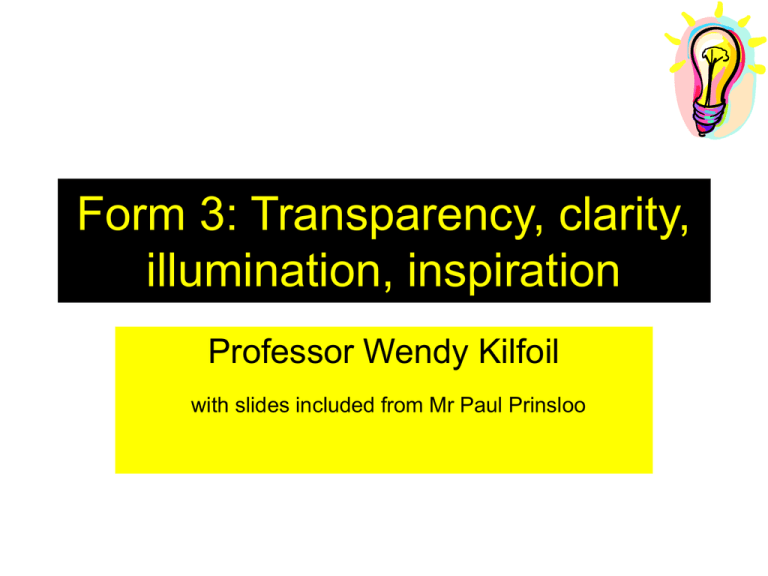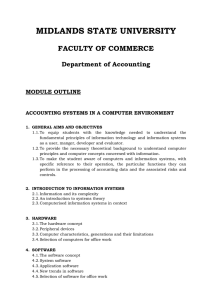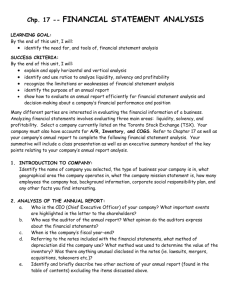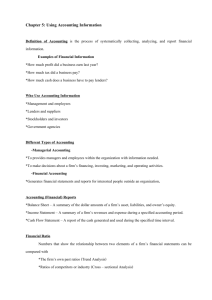An intelligent approach to Form 3
advertisement

Form 3: Transparency, clarity, illumination, inspiration Professor Wendy Kilfoil with slides included from Mr Paul Prinsloo Getting to ‘aha!’ AHA!! ? ? • The field: the discipline, the educational pathway, the career possibilities, workplace practicalities, professional standards, how people learn, etc. • Form 3: This form should capture the indepth conceptualization that precedes it. • Learning environments and experiences: print, multi-media, online, workplace Form 3 as the crystallization of a process involving ... Lecturer(s) Field Form 3 Observe, observe, observe Prototyping: co-creating Design Stakeholders Team Sensing from the field Crystallizing purpose, etc. Letting go Letting come Reflection Adapted from Paul Prinsloo, July 2006 Transformational OBE • Focus on the need for a new society and the service of humanity: What kind of society do we want? • What type of graduate in this field will contribute to that type of society? • Focus on the critical cross-field outcomes as indicators: What generic competencies will a graduate in this field have? • How will this module contribute to the graduateness of the student? Adapted from Paul Prinsloo From Paul Prinsloo From Paul Prinsloo If these are the outcomes that will allow them to have an impact, … What evidence should we require to prove to them (and us) that they have everything that they need to have the intended impact and what standards will they have to meet? Assessment criteria Adapted from Paul Prinsloo What is the function of the purpose statement? • a higher level, global capturing of the outcomes • focus on the student, not on a transmission model that has the university ‘equipping’ students to do something • use of purpose statement in university: calendar entry Example: Unpacking purpose statements • This module is useful to students who are required to manage a customer service division in an organization. • Outcomes – apply general managerial principles in a customer service environment. – manage employees in the customer service division of an organization. – identify, interpret and act upon environmental issues impacting of customer service provision. – develop a customer service plan for an organization. – evaluate customer service provision and implement remedial actions. Knowledge assumed to be in place • Sometimes there are ‘hard’ pre-requisites such as calculus. • At other times, particularly for Level 5, the skills are generic but in that case the CCFOs could be used as a guide: problem solving, data gathering, communication (particularly reading). • From Level 6, knowledge could focus on level descriptors of previous level. Example of knowledge assumed to be in place: NQF 6 • The following levels of learning ought to be in place to ensure successful completion of this module: – At least one year’s experience in organisation development practice – Experience of facilitating group processes. – Demonstrated proficiency in the following: • the ability to learn from predominantly written material. • the ability to present and communicate information and opinions in well-structured arguments without support. • taking responsibility for their own progress and, • being willing to take part in experiential learning of a personal nature. Examples of knowledge assumed to be in place: Level 5 • communication in the language of instruction, i.e. English • performing calculations by means of a calculator Examples: Range statements • NQF 6 – Organizational Development (OD) interventions are done on individual, group and organizational levels in organizations. • NQF 5 – sole proprietorships, close corporations and companies – agricultural, mining, manufacturing, retailing, service and financial services firms What is an outcome? • A statement of competence in terms of the knowledge, skills, attitudes and values a student will have as a result of successful learning in a particular field • ALERT! Outcomes are often thinly disguised tasks or content. What is the function of assessment criteria? • Assessment criteria are standards-driven. • They relate to specific learning experiences and environments. – ALERT! Some focus inappropriately on workplace environments when the learning environment at Unisa is paper-based. • They are not content or a reformulation of the outcome statement. Example: Outcomes and assessment criteria • Specific outcome – analyze and interpret an income statement, balance sheet and cash flow statement • Range – profitability, liquidity, solvency, activity and market ratios • Assessment criteria – The firm is evaluated as an investment opportunity. – Suggestions are made on ways in which the firm’s profitability, liquidity and solvency may be improved. – Financial information in financial statements is summarized accurately. – Profitability ratios are calculated and interpreted accurately. – Liquidity ratios are calculated and interpreted accurately. – Activity ratios are calculated and interpreted accurately. – Solvency ratios are calculated and interpreted accurately. – Managerial actions to be taken are identified based on financial analysis. Example: Outcomes and assessment criteria • Specific outcome – Explain the concept of Appreciative Inquiry (AI) as a constructive approach to OD • Range – OD refers to Organizational Development that is based on a problem-solving approach to change management • Assessment criteria – An appreciative approach to OD is differentiated correctly from a problem solving approach. – The theoretical underpinnings of the concept, namely social constructivism, humanism, existentialism, image-action connection, role of language and inquiry in image creation, are correctly identified and explained. – The emerging paradigm as context for AI is described correctly; – Three different models of the AI process are compared to identify their strengths. – Applications such as strategic planning, organization and business process design, quality improvement, career counseling, mergers and acquisitions, team building and diversity initiatives are described from an AI perspective. Critical cross-field outcomes • Critical cross-field outcomes must be carefully targetted. • The achievement of the designated CCFOs must be integrated into the assessment criteria for the specific outcomes. Example: Incorporating CCFO • Specific outcome – Apply general management principles in a customer service environment. • Range – The four general management principles of planning, organizing, directing and controlling are applied to customer service management in any organisation in Southern Africa. • Assessment criteria: – General management principles are applied in a customer service environment when • the importance of customer service to organizations can be shown. • a manager can intervene in customer service provision when the situation requires it. – The value of group/ team work is made clear. (CCFO) – Communication is unambiguous and accurate. (CCFO) – Problems are correctly identified and analyzed and a variety of solutions proposed and prioritized. (CCFO) Getting to ‘aha!’ Conceptualizing in a team Crystallizing in Form 3 Designing learning environments and experiences AHA!!







